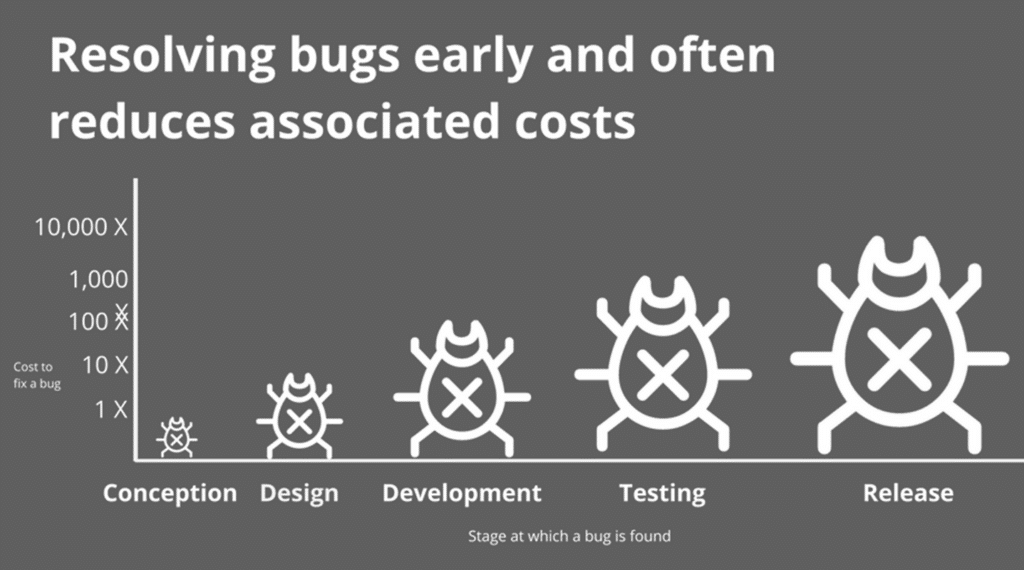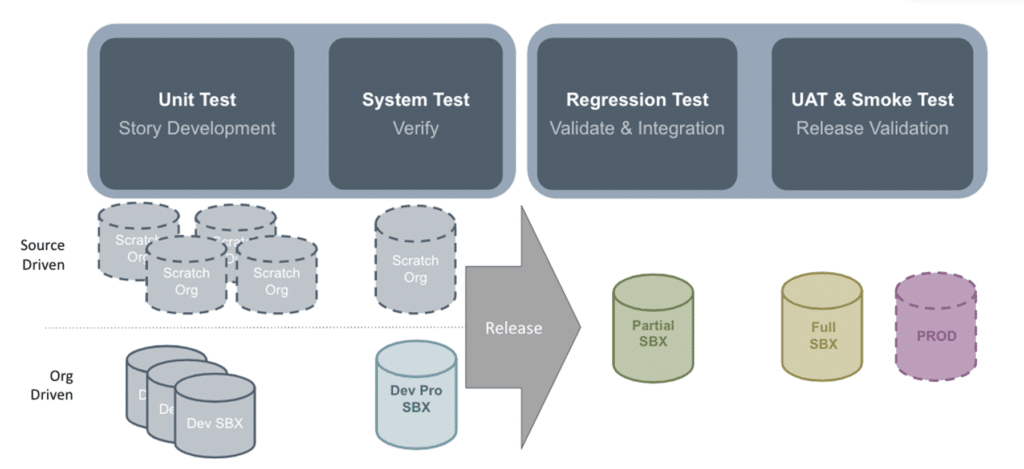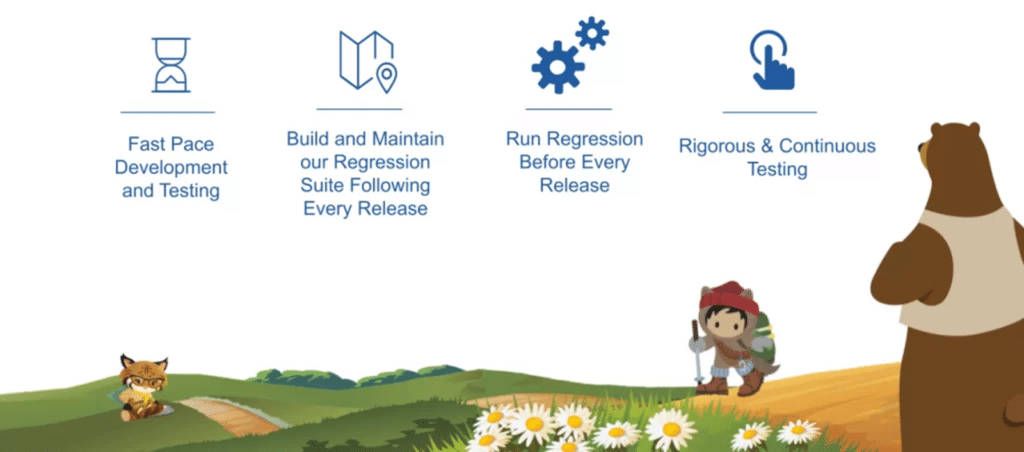Salesforce Test Automation Tools: It is used to keep an eye on apps and make sure Salesforce operations are carried out consistently. Generally speaking, automated testing consists of scripts that run against your code to see if certain components function as intended. Several pieces of software can be used to develop and execute Salesforce Test Automation.

Table of Contents
ToggleWhy Automate Tests for Salesforce?
Let’s not waste too much time on something that seems obvious: let me reword this as “Why Manual AND Automated Testing Matters.” The CTO of a test automation business may surprise you by telling you that you should aim for something other than 100% automation because manual testing has its uses as well. Later on, we’ll investigate this more.
For many consultants, testing is where you discover all the amazing stuff you wrote, regardless of whether you identify as an admin or a developer.
- Does not function as planned
- Fulfils all requirements specified in the tale acceptance criteria but needs to meet what your users or stakeholders truly want.
- Functions exactly as anticipated and consistently beyond expectations

“Test early and test often” is a phrase that is frequently employed. While many teams find success with Test Driven Development (TDD), I’m not talking about that approach here. What I’m getting at is something much more basic: there’s a surprisingly high return on investment when issues are fixed early on.
The Advantages of Automating Salesforce in Salesforce Test Automation Tools
- Higher testing accuracy Higher testing speed
- reduction of risk
- Enhanced coverage of tests
- the quicker cycle of delivery and release
- Improved quality of the product
- Lower expenses
- increased edge over competitors
All of these advantages are connected. For instance, increased speed and accuracy allow for increased test coverage, which enhances product quality.
Difficulties with Salesforce Test Automation Tools
Automating Salesforce is particularly challenging when compared to other systems.
Although Salesforce’s underlying software is difficult to access for users who want to automate tasks, the interface is easy to use and navigate because of its design and construction.
Technically speaking, Salesforce is challenging to automate for the following reasons:
- Regular system updates: When Salesforce modifies the platform, it may affect current procedures.
- Salesforce isolates components by using Shadow DOMs. This complicates the process of identifying components in UI test automation.
- Heavy DOM structure: Automation tools find it challenging to access Salesforce’s intricate DOM structure.
- Salesforce elements have their element identifiers hidden for development reasons, which makes test automation challenging.
- Dynamic elements: Since elements vary regularly, automating Salesforce requires an element locator technique.
- Iframes: Because the UI automation tool must recognize the objects beneath the frame, it is challenging to identify Salesforce Iframes.
When Should You Take a Test?
- Which you choose to adopt primarily depends on your software delivery process; however, the when can be more easily addressed by traditional testing methodologies. Although I’m assuming that everyone is using an agile process, a lot of this also applies to waterfall development.
Motives for Starting Tests
First off, there are four primary justifications for starting tests on Salesforce:
- Management of Change: Nearly all Salesforce organizations frequently modify their system to improve them, utilize new capabilities, or extend usage to additional teams. Salesforce’s remarkable success in organic development can be attributed to its adaptability and ability to yield tangible commercial advantages.
- Testing of Releases: Salesforce publishes three updates every year, each with a pre-release and a sandbox preview phase. This will enable you to identify problems before they affect your production organizations. Make sensible use of it. Before making any changes, you should prioritize thorough regression testing during release testing and repeat that testing afterwards.
- Testing of Release Updates: Salesforce has a new moniker (it was formerly known as Critical Updates), but through release updates or feature flags, it is offering an increasing number of features, both functional and non-functional. With this, you can make a change, evaluate its effects, and roll it back using a practical procedure. Normally, the modifications are intended to become automatically active in a later version, but this gives you more time to assess the effects.
- Integration Examination: Many businesses have connected other systems to rely on the data from their CRM, which is the core of their operations. If you’re making changes to those auxiliary systems, you have to make sure that your integrations continue to function normally and regularly, or even hourly.
Main Testing Stages in Salesforce
In a typical change lifecycle, there are several test phases to take into account in addition to the above trigger points for doing tests. On a Salesforce project or BAU team, the main testing steps to take into account are:
- Test Design: Unfortunately, this is rarely done in Salesforce installations, but if you’re starting a new application or making significant modifications to an existing one, giving users access to a clickable prototype and soliciting their input will help you identify any usability problems or dead ends in the navigation.
- Testing Units: Sadly, the majority of individuals discussing unit testing on Salesforce are fixated on passing Apex code coverage and, ideally, including significant assertions and limit checks. Thus, when I refer to “unit testing,” I mean the procedure whereby someone makes a change and then tests to make sure it functions as intended before implementing the change. This covers both declarative and low-code/code modifications.
- System Examination: Most people are aware of system testing, which often entails having a test resource examine the modifications to ensure they adhere to acceptance criteria and/or a predetermined test plan that includes scenarios and variants.
- Testing for Regression: Regression testing ought to be an automated procedure that is launched daily on a planned basis or at least a component of a Continuous Delivery (CD) pipeline.
- Testing for Smoke: Smoke testing is frequently used to confirm that a change has been implemented instead of conducting a complete regression test.
- Acceptance Testing for Users (UAT): Unbelievably, I’ve worked on projects where the client has sought proof from our system testing phase since they need more resources to conduct UAT. I have an entire talk to give about avoiding that circumstance and that topic.
Where to Test?
The majority of the businesses I’ve dealt with are rather advanced in this regard, and those days should be in the past now that we don’t have a Sandbox to work with. You ought to be able to adhere to the aforementioned minimal configuration starting with Enterprise Edition but with Dev sandboxes in cases where there aren’t enough DevPro, Partial Copy, or Full sandboxes.

When it comes to testing, the two primary methods—source-driven and org-driven development—are essentially the same.
- Before pushing changes, submitting a pull request, and committing to your source repository, you should finish all of your unit testing for a change or story in a scratch organization if you’re using a source-driven methodology.
- For all unit tests, as well as for system testing of several stories as part of an epic or sprint validation, you can keep utilizing a Scratch Org.
- Similarly, suppose you’re utilizing a more conventional approach to org-driven development. In that case, you’ll be developing your changes in one or more Dev sandboxes before submitting them to, say, a Dev Pro sandbox, which already has a portion of test data provided.
What Should Be Examined?
- Up until now, almost everything has been reasonably generic. This is where things get really specialized to Salesforce.
- What should be tested depends on several criteria, including your company’s risk appetite, regulatory compliance, the caliber of solutions being tested, and, most importantly, the testing steps I outlined above.
- It is simple to quantify the benefits of testing and the value gained from automating certain of those tests.
- To encapsulate my ideas, I’ve divided the following into a table and given a priority for each area of modification that may be made in comparison to the testing techniques mentioned above. Changes where the same set of suggestions apply have been grouped.

What Should You NOT Test?
As crucial as knowing what to test, I’d like to point out a few things for which, in my opinion, tests should not be made.
While we do occasionally see users add tests for these items—which is necessary for users in regulated industries—most of the time you’ve paid for a subscription to an app that has already undergone testing thus you are not obliged to test the following:
- Navigation between main and sub-tabs in the console unless you want to confirm that linked items are deployed as main or sub-tabs
- Salesforce Associated list See Every Link.
- Using the App Launcher, switch between Apps and Tabs. Salesforce has already tested the app switching process as a UI delivery; tools like Provar handle this for you.
- Filtering and sorting in list view should be avoided unless you’re utilizing it for a particular test case.
- Use the utility bar’s recent items, history, notes, etc., but limit yourself to any quick actions you design. If you have customization, only use it for posting, liking, or commenting on posts.
In summary
Salesforce test automation is crucial for maintaining the reliability and effectiveness of Salesforce apps.
By utilizing appropriate tools and best practices, organizations can assure high-quality deployments, minimize testing requirements, and expedite release cycles.
Including automated testing in your Salesforce development process allows your team to concentrate on strategic ambitions and innovation while simultaneously improving the dependability of your applications.
To maximize the return on your Salesforce efforts, embrace Salesforce test automation now.







